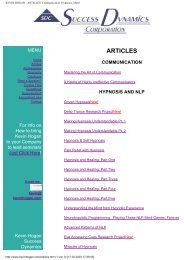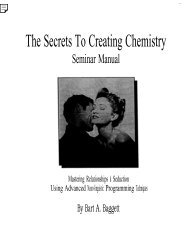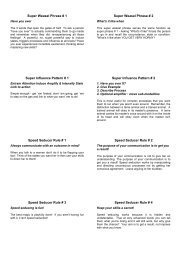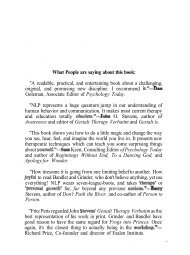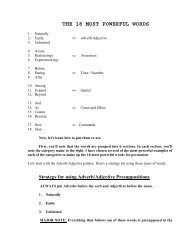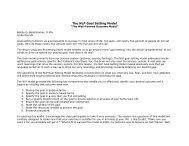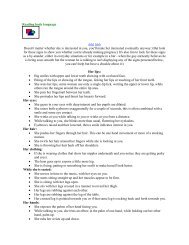A Pragmatic Guide To Communication & Change.pdf - NLP Info Centre
A Pragmatic Guide To Communication & Change.pdf - NLP Info Centre
A Pragmatic Guide To Communication & Change.pdf - NLP Info Centre
- No tags were found...
You also want an ePaper? Increase the reach of your titles
YUMPU automatically turns print PDFs into web optimized ePapers that Google loves.
Several years ago, I had a client who demonstrated perfectly the duality in function of the<br />
universal human modeling processes. What follows are highlights from some of our<br />
sessions that exemplify these processes in action.<br />
As a child, Sharon had several very pleasant experiences in a particular reading group.<br />
These experiences were soon generalized to all reading, and Sharon became an enthusiastic<br />
"bookworm." This can be considered a positive example of the process of<br />
generalization.<br />
One of the reasons Sharon decided to come in for counseling was what she termed "a fear<br />
of men." This "fear" kept her from relaxing enough to have any close, affectionate<br />
relationships. In her words, "Men frighten me. I'm afraid all they want is to take<br />
advantage of me." We quickly uncovered where her fear had come from: Sharon<br />
recounted a severely traumatic experience she had had with a man when she was a young<br />
teenager. From this one terrible experience she had begun to generalize about the<br />
"motives" of men. These generalizations had become a part of her model of the world and<br />
effectively prevented her from enjoying the close, loving relationship that she so dearly<br />
wanted. As with her experiences with reading, this modeling process occurred<br />
"automatically," completely out of her conscious awareness.<br />
6<br />
concentrate, to plan and learn, and to dream. They become evident to the trained observer<br />
through a person's speech and behavior, and learning to detect and utilize these universal<br />
processes is a central theme of this book.<br />
Generalization<br />
The process of generalization provides part of the explanation of how we are able to learn<br />
as rapidly as we do. Many "new" behaviors, for example, are actually composed of bits<br />
and pieces of previously experienced behaviors which are similar to the new behavior.<br />
Because of this similarity, we are able to generalize from the experience of the old<br />
behavior, alleviating the need to learn the new behavior "from scratch." The ability to<br />
generalize from past experiences means that it is not necessary to expend great amounts<br />
of time and energy learning new behaviors. This same process is utilized in the learning<br />
of new concepts and in other activities associated with what we call "thinking." In<br />
essence, generalization eliminates the necessity to relearn a concept or behavior every<br />
time we are confronted with a variation of the original.<br />
Deletion<br />
It has been reported that the human central nervous system is being fed more than two<br />
million pieces of information euery second. Just in terms of efficiency, if every bit of this<br />
information had to be processed and used, the time and energy necessary would be<br />
astronomical! This is where the process of deletion comes in. Our central nervous system<br />
actually operates as a "screening mechanism" enabling us to function at peak efficiency.<br />
As Alders Huxley says in The Doors of Perception, experience "has to be funneled<br />
through the reducing valve of the brain and nervous system. What comes out the other<br />
end is a measly trickle of the kind of consciousness which will help us to stay alive on the<br />
surface of this particular planet." (p. 23)<br />
Obviously, our ability to delete portions of the barrage of input is essential to our<br />
survival.



